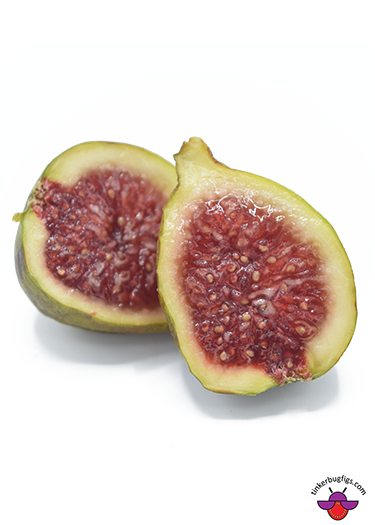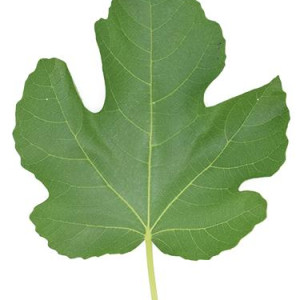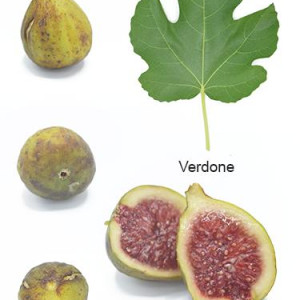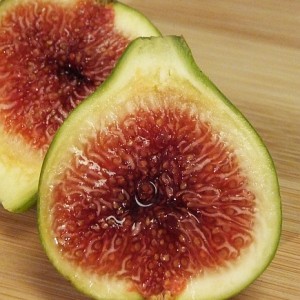This site contains affiliate links for which I may be compensated.
Verdone
Verdone Information


-
Possible Synonyms / AKA:
Grosse Verte, Nebian, Adriatic, White Adriatic, Fico di Fragola, Strawberry, Verte
According to Dr. Condit the Strawberry is also known by the following names: Verdone, Coeur, Figue d'Espagne, Verdae, Ischia Green. Of these Verdone is considered by Condit to be the most accurate.
-
Introduced By:
-
Origin:
Italy -
Main Flavor Group:
Adriatic - delivers a balanced sweetness with a refreshing, light flavor. It combines subtle berry-like notes. Yellow or green skin and usually red pulp, with more complex additional flavors developing when fully ripe. -
Family Group:
Adriatic -
Fig Type:
Common - Self fertile and will grow anywhere conditions are suitable -
Cold Hardy:
Yes -
Container Variety:
Yes -
Easy Rooting:
N/A -
Main Season:
early -
Availability:
Average -
Breba Crop:
Yes -
Seed Crunch:
N/A -
Eye:
N/A -
Skin Toughness:
N/A -
Fruit Size:
Medium to large -
Rain Resistance:
N/A -
Tree Vigor:
N/A -
External Links:
https://www.ourfigs.com/forum/figs-home/612250-verdone-2019
Description
An older cultivar that produces a large, sweet, rich, green yellow, very fine flavor fig. Two crops annually. High quality category from Italy. You can find more info on this variety by searching the information posted on Adriatic.
Condit Monograph
Verdone: (syns. Grosse Verte, Nebian, Adriatic, White Adriatic, Fico di Fragola, Strawberry). Described as Verdone by Gallesio (1817), Gasparrini (1845), and West (1882). Described as Grosse Verte by Audibert Frères (1854) and Barron (1867, 1868a, with outline drawing). Described as Nebian by Hogg (1866), Wright (1894), and E. A. Bunyard (1925). Described as Adriatic by Eisen (1885, 1887, 1888, 1897, 1901), Massey (1893), Forrer (1894), Colby (1894), Earle (1900), Wythes (1902), Starnes (1903), Starnes and Monroe (1907, with figure), Mills (1914), Roeding (1914), Potts (1917), Roberts (1917); Condit (1920d, 1921c, 1923, 1933, 1947), Davis (1928), Burger and DE Wet (1931), Grasovsky and Weitz (1932), and by Woodroof and Bailey (1931). See account and color plate of Adriatic by Lelong (1890) and by Taylor (1898); trees are figured by Condit (1933).
In 1727, Richard Bradley reported that he had introduced the Verdone fig into England from Italy. Almost a hundred years later, Gallesio published a good account of this variety, then extensively grown in the vicinity of Rome. Gasparrini briefly described it, giving credit to Gallesio for his earlier account; but other Italian writers apparently ignore it. Verde Gentil, described by Tamaro (1948) may be the same variety. The name Verdone (“greenfinch”) was given on account of the green color of the skin. With the exception of Audibert Frères, who called it Grosse Verte, French authors omit reference to this variety. The origin and significance of the name Nebian, used by Hogg, have not been determined. Bunyard stated that Nebian is much grown in California for drying, under the name Adriatic. Davis, also Burger and DE Wet, report that in South Africa the White Adriatic is a very consistent bearer of figs, good for jam and for drying. Grasovsky and Weitz state that it produces good crops of high- quality fruit in Palestine. Barron (1868a) described Grosse Verte as “one of the largest, handsomest, and richest-flavored varieties in cultivation—well suited for pot culture.” Starnes found White Adriatic an excellent variety in Georgia.
The following notes on the Verdone (White Adriatic) in California are taken from the account by Eisen (1901, p.70). The first importation was made by W. B. West from an English nursery, via Panama, in 1865. Later, Dr. Sposati, of Stockton, is said to have received the same variety from his native home in Italy under the name Fico di Fragola, or “strawberry fig.” G. N. Milco found ten-year-old trees growing on the Captain Gray ranch at Atwater, recognized their value, and labeled them “Adriatic” as stated by Milco (1885). Milco “did much toward making the variety known, but also much toward keeping the growers in the dark as regards its true nature. Since 1884 the variety has been extensively cultivated in California and distributed to many of the southern states, especially Florida. It is a fine variety in some localities, but in others worthless.” See also discussion by Milco and others (1887), on varieties.
The Chiswick collection from England included Nebian as P.I. No. 18,863 and Grosse Verte as P.I. No. 18,876. These two proved to be identical in the plantings at Niles and Chico. At the California Experiment Stations, from 1893 to 1901, trees of the Verdone (Adriatic) grew vigorously, but at Tulare they were very susceptible to Frost Damage , and the second-crop figs soured badly. (See report of Forrer, 1894.) However, commercial plantings, made in both the Sacramento and San Joaquin valleys, proved the adaptability of the variety to climatic and soil conditions, and for several decades it was the largest producer of dried figs in California. The bearing acreage of Verdone trees in 1953 was 6,921, and in 1952-1953 there were 7,699 tons of dried figs shipped to the trade. In comparison, the Sari Lop (Calimyrna) acreage was 10,267, and 9,505 tons were marketed as dried fruit.
Trees of the Verdone planted in dooryards are not so satisfactory for production of figs for home use as are certain other kinds, on account of the lack of a first crop and the susceptibility of the fruit to spoilage. In the vicinity of Los Angeles, however, good results have been secured by heavy pruning of trees and the resultant production of a crop which matures late in the season. The influence of climate upon fruit characters is especially marked in this variety. Condit (1950) states that “figs picked at Merced, in the interior valley, on September 24, 1949, for example, showed a pulp light strawberry in color, and a meat thin and white. Figs of the same variety, picked three days later at Mission San Jose, where the climate is cool, showed the pulp to be blood red and the meat tinged with violet.”
The following account of Verdone is based on observations of commercial plantings and of individual trees over a long period, and of trees fruiting in the collection of varieties at Riverside since 1932.
Trees vigorous, densely branched, with broad, spreading crown. (Plate 2.) (See also Condit, 1941a, fig. 15.) Terminal buds green. As already pointed out (Condit, 1947, p.103), leaves of Verdone trees appear a week or ten days before those of Sari Lop and may, therefore, be seriously injured by late frosts, while leaves of the latter escape injury. Leaves medium, decidedly glossy above, stiff in texture, mostly 5-lobed; upper sinuses deep, moderately broad, lower sinuses fairly shallow; base broadly subcordate to truncate; middle lobe spatulate, with upper margins coarsely crenate, lower margins entire; leaf mosaic fairly conspicuous, with occasional twigs having badly distorted and dwarfed leaves, as shown by Condit and Home (1933). (See also plate 13.)
Breba crop very small, or none (crop of 1953 was unusually heavy as the result of Frost Damage to terminal buds and the resultant pushing out of lateral fruit buds); figs medium or above, oblique-pyriform, mostly with prominent neck, up to 3/4 inch long; stalk thick, sometimes swollen, up to 1/4 inch long; ribs narrow, inconspicuous; white flecks fairly numerous and prominent; eye medium, scales greenish, with scarious margins; skin thin, colored greenish violet by the underlying dark-violet meat; pulp dark strawberry; flavor rich; quality good. (Plates 7; 16, D.)
Second crop good; figs in hot, interior valleys are medium; turbinate, with or without short, thick neck; average weight 50 grams; stalk up to 3/4 inch long, often somewhat curved; ribs slightly elevated, but hardly prominent; eye medium, open, scales chaffy, straw to flesh color, or sometimes pink; surface dull, with delicate bloom; white flecks large, prominent, widely scattered; color green to greenish yellow; meat thin, white; pulp light strawberry, somewhat hollow at the center. Flavor fairly rich, of a characteristic fig type. Quality good, especially for drying. In cool climates figs are large, grass green outside; pulp blood red; quality excellent. (Plates 8; 16, C.)
Caprified figs are medium or above, deep green; pulp solid, dark red; flavor peculiarly Acid . As many as 1,600 fertile seeds in a single fruit. (Plate 11.)
If you'd like your banner to be shown here and throughout Fig Database, send us a message.
Photos Add Your Image
YouTube Videos
No Videos Found










